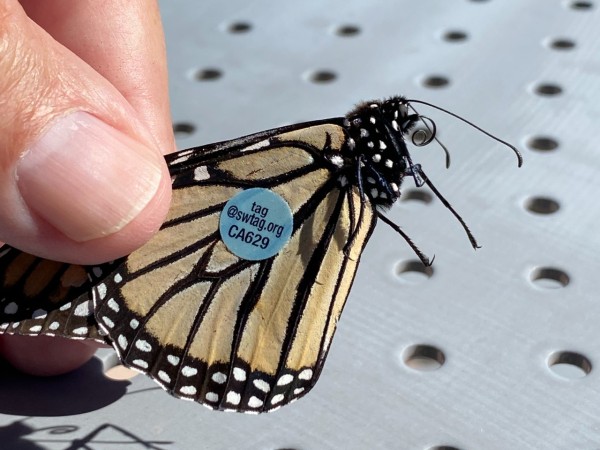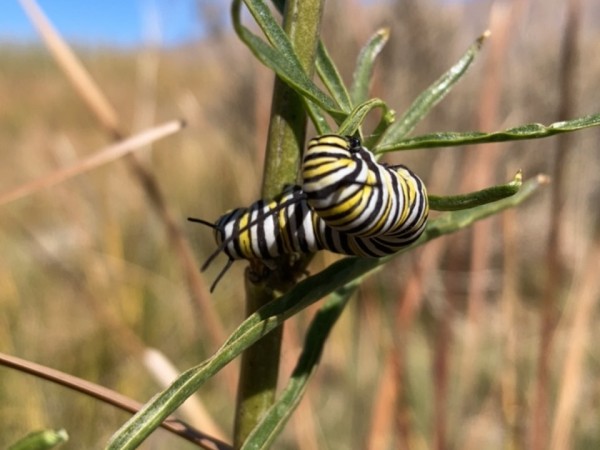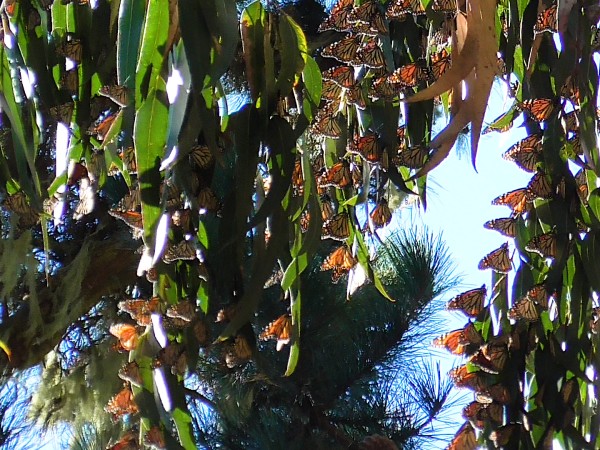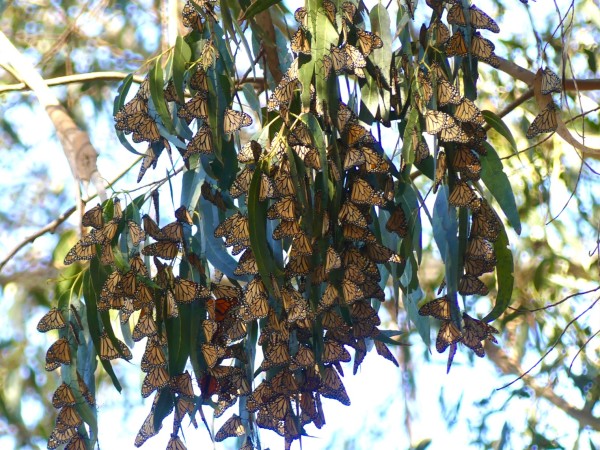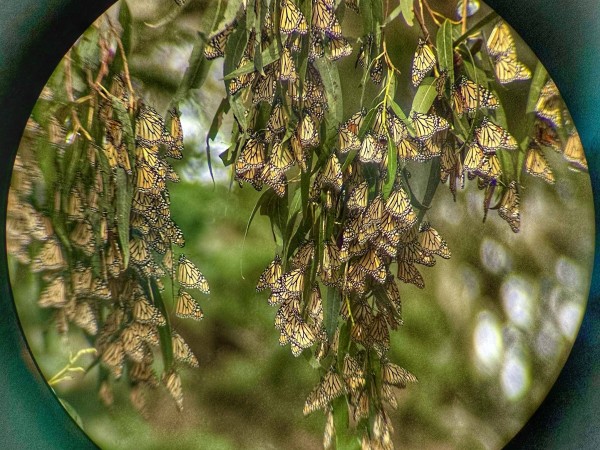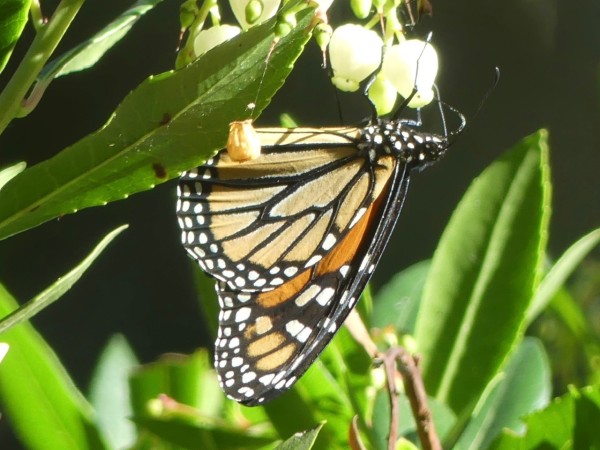Letter From Gail Morris: Western Monarch Fall 2022 Report #5
Published: 11/08/2022
Dear Western Monarch Friends,
Community science reports this week reveal monarchs hurrying on their way to their winter homes with sightings across central California and Arizona.
Two field reports from Erin just east of the Sierra Nevada range in Blackrock and Lone Pine, California, indicated monarchs observed were flying SOUTH rather than in a westerly direction to the coast. Were colder temperatures in mountain passes a concern or were these monarchs heading to the Baja peninsula in Mexico?
Along the coast near Los Angeles there were reports of 24 monarchs in trees in El Segundo and Santa Monica reports show monarchs gathering in trees near tennis courts.
Susan in El Segundo, CA exclaimed, “There back!” when she found a roost of about 24 monarchs in a pine tree.
In Arizona, nine monarchs were tagged in Green Valley, in SE Arizona.
James in Green Valley, AZ submitted a photo of a tagged monarch and noted, “All were nectaring on Lantana or Gregg's mistflower. One nectaring on A. subulata blossom.” (10/28/2022)
Be sure to view these reports and many more on the real-time Journey North map. What fall migration patterns are you seeing emerge?
Note some locations have monarchs that appear to be breeding and not migrating.
As Erin noted from Blackrock, CA: “Four caterpillars seen along the Owens River.”
West Coast Monarch Overwintering Sites
Meantime, last week brought the first storm of the season. The Journey North map shows how new arrivals at the overwintering sites fared. A new Pacific storm is barreling down the coast bringing California rain and mountain snow to the overwintering region. Your reports will help us all learn how monarchs survive this special season.
Reports from several north central overwintering sites give us a snapshot of monarch activity this week.
Pacific Grove Update
Stephanie Turcotte sends in lively reports about monarch positioning within Pacific Grove as they gather and their response to the first storm of the season.
On October 28th, Stephanie sent in her observational report from the Pacific Grove Sanctuary. “It’s always nice to be able to share happy news! “The ‘happy’ report is that Pacific Grove Sanctuary numbers did increase substantially since last week’s official count. This morning (10/28/22) the monarch count is: 11,213. They were clustered on 19 different trees (Eucalyptus, Monterey pines and Monterey cypress) The largest clusters of approximately 2,900 monarchs were actually on a Monterey pine inside the grove, just along the footpath. The trees were mostly in the southern end of the grove and in the western end. [It is important to remember that] last year on 10/29/21 the count was 9,544. Not only are the monarchs utilizing the trees inside the monarch habitat, but they are, once again, clustered in the neighbors’ yards, on Monterey pines. A fair number of monarchs are clustering on Eucalyptus branches extending from the fence line, facing south, in order to capture the first rays of sun.”
On November 11th, Stephanie shared an updated report, “We had our first weather event last week, not too severe, just some rain and mild wind. I checked the PG grove before and after the storm to see how the monarchs were reacting. There were quite a few flying in the wind, before the rain came, seemingly repositioning themselves. There was some mortality, but not too much. The rain wasn’t so heavy this time around. There was definite movement noted. Our count this morning in Pacific Grove was 11,171. So there was no increase as we saw last year from one week to the next (10/29/21 9,544 to 11/6/21 13,708). They are still dispersed between Eucalyptus, Monterey pines, Monterey cypress on the south, east and west ends of the grove- 24 trees. They are utilizing 3 trees in the neighbor’s yards. The highest numbers are still concentrated on the Monterey pine overhanging the path, inside the sanctuary, just above 4,000. There are fewer at the west end of the grove, which makes sense because of the wind exposure off the ocean on that side."
In closing, Stephanie has these wonderful words of advice, “If you need a boost in spirit, just walk through an overwintering habitat hosting thousands of monarchs! There are plenty of monarchs for visitors to see with or without binoculars!”
Natural Bridge State Park and Lighthouse Fields Update
On October 29th, Diana Magor shared her field reports from Natural Bridge State Park and Lighthouse Fields. Diana noted, “My estimate today 10/29/22 for LField [Lighthouse Field] was 980. I saw a burst (cascade) this morning of over 100 monarchs due to a branch break. Fortunately, it was warm enough for them all to fly! On November 5th, our Santa Cruz monarch estimates were 1,200 monarchs at Lighthouse Field and 6,500 monarchs at Natural Bridges State Park. Santa Cruz numbers are definitely up. I was surprised today (November 5th) to see so many more clusters on the inside of the sanctuary compared to last week. It’s been colder and rainy though, and they tend to shelter inside in those circumstances. I observed a cascade of over a hundred the other day…I rechecked numbers this afternoon (November 6th) atLighthouse Field and estimated 2,150 an increase from yesterday.”
Pismo Beach
Every grove has different counters each week now and they will solidify during the official counts starting next weekend. Sometimes it is a group of volunteers that rotate through each week, sometimes there is an official team who does the counts weekly or seasonally. Marylou Barker Goodan reports the newest update from Pismo Beach. On October 31st, Marylou noted that “Based on an official count by Stephanie Turcotte and the environmental science team, 24,052 monarchs were clustered in 3 trees.”
Thank You!
A special thank you to Stephanie Turcotte, Diana Magor, and Marylou Barker Goodan for their reports and photos and Robert Pacelli for his photos at Pacific Grove. We will be waiting to see how the monarch numbers continue to grow as the annual Thanksgiving Count approaches.
Send in your reports!
If you are out this week and see monarchs of any life stage, be sure to report them to Journey North—whether they are adults or eggs or larvae. Provide as much information as you can such as weather conditions (it’s okay to estimate). Your detailed description of what you see can include, but is not limited to, the monarch’s gender and activity and, if known, the type of flowers if they are nectaring. Let us know how monarchs are faring under stressors from winter storms sweeping through!
Gail Morris is the Coordinator of the Southwest Monarch Study (www.swmonarchs.org), a Monarch Watch Conservation Specialist, and the Vice President of the Monarch Butterfly Fund, the Central Arizona Butterfly Association and the Western Monarch Advocates. The Western Monarch Population News is based on comments provided to Gail Morris. We hope to increase the number of sightings and therefore photos and comments entered into Journey North. We rely on the volunteers who communicate regularly with Gail and who agree to participate in our effort to increase awareness of the population of western Monarchs. You can reach her at gail@swmonarchs.org

